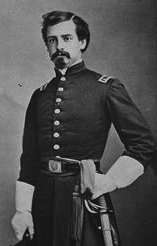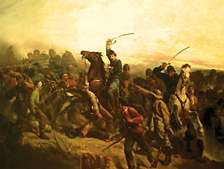Henry B. Hidden
| Henry B. Hidden | |
|---|---|
 | |
| Born |
1839 New York City |
| Died |
March 9, 1862 (aged 22–23) Sangster's Station, Virginia |
| Buried at | Green-Wood Cemetery, Brooklyn, New York |
| Allegiance |
United States of America Union |
| Service/branch | Union Army |
| Years of service | 1861 – 1862 |
| Rank | First Lieutenant |
| Unit | 1st Regiment New York Volunteer Cavalry |
| Battles/wars | Sangster's Station † |
| Relations | William Henry Webb |
Henry B. Hidden (c. 1839, New York City – March 9, 1862, Sangster's Station, Virginia) was a First Lieutenant in the Union Army during the American Civil War. Hidden is believed to be the first cavalry officer killed in action in the Army of the Potomac and the first officer of Union volunteer cavalry killed in the Civil War.[1]
Biography
Henry B. Hidden was born in New York City to a wealthy family related to the shipwright William Henry Webb. He enlisted in the Union Army on August 5, 1861, at New York City, and was commissioned a 1st Lieutenant of Company H, 1st Regiment New York Volunteer Cavalry, a regiment also called the "Lincoln Cavalry." On March 9, 1862, Hidden was ordered to take a small scouting party to investigate enemy activity near a bridge Union soldiers were building at Sangster's Station, a railroad station southwest of Fairfax Station, Virginia. Hidden and his party of 14 dragoons encountered an estimated 150 Confederate soldiers. Although vastly outnumbered, Hidden ordered a charge. In the resulting skirmish, he was shot in the neck and died soon afterward. The rest of the scouting party was wounded or captured.[1]
Hidden was buried in Green-Wood Cemetery in Brooklyn, New York.[2]
Artistic depictions of Hidden's charge

Hidden's charge sparked the imagination of several artists in subsequent years. Victor Nehlig painted An Episode of the War — The Cavalry Charge of Lt. Henry B. Hidden in 1875, and Frank Leslie illustrated the Sangster's Station skirmish in The Soldier of Our Civil War (1893). The former is on display in the New-York Historical Society's Henry Luce III Center for the Study of American Culture.
Additionally, the New York Evening Post printed a poem inspired by his charge.[1]
See also
References
- 1 2 3 Hammerson, Michael (Mar–Apr 2003). "The First to Fall". Military Images. Retrieved 2008-11-01.
- ↑ Collins, Glenn (2003-07-04). "Stories of the Civil War, Carved on Headstones; Volunteers Unearth Names and History At Green-Wood Cemetery in Brooklyn". The New York Times. Retrieved 2008-11-01.